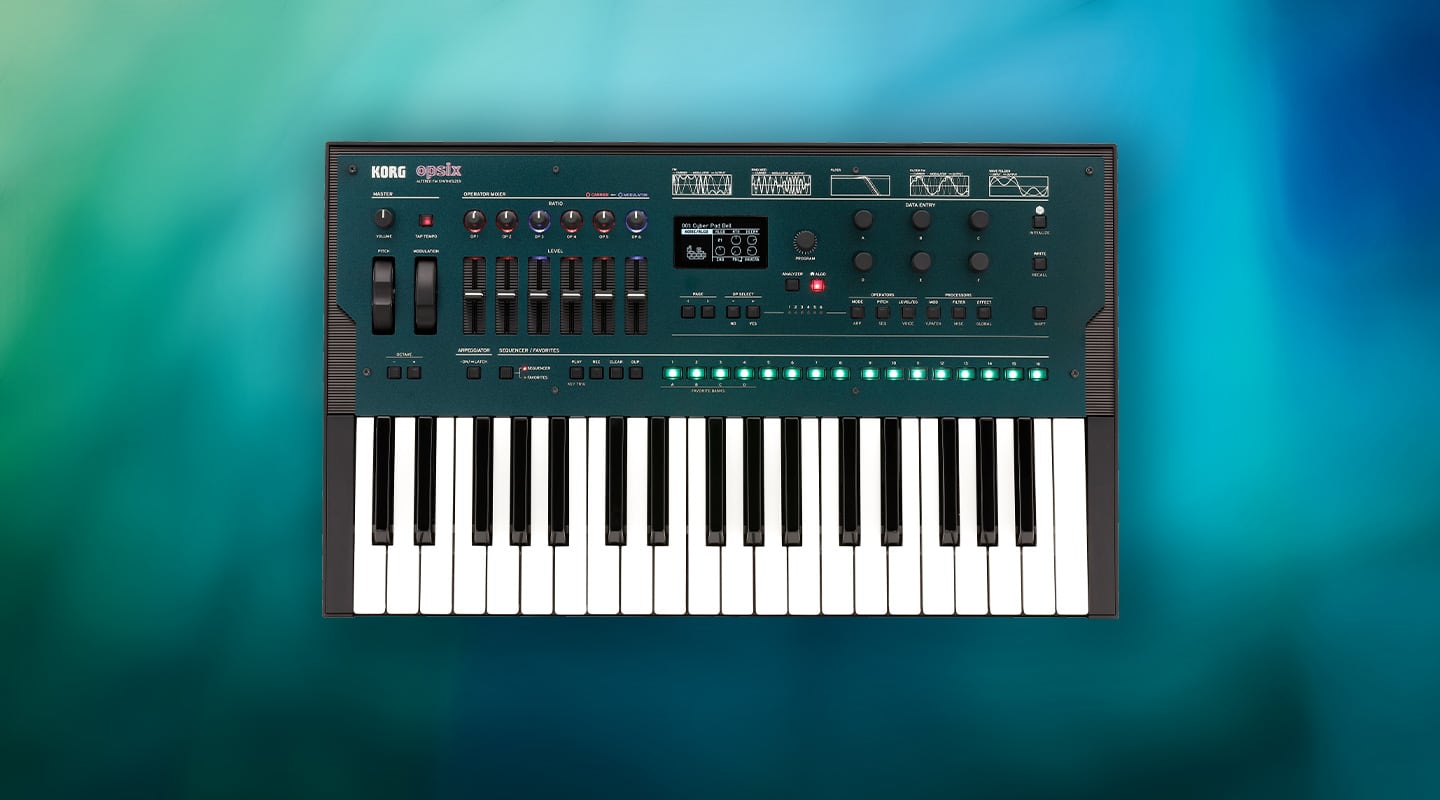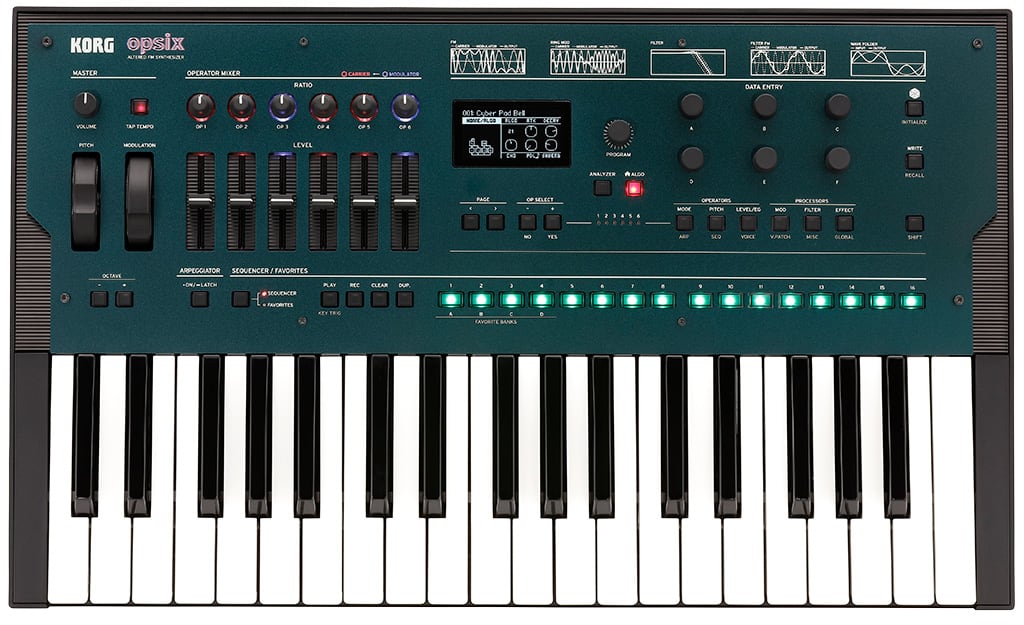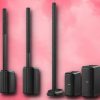
Review: Korg OpSix Altered FM Synthesizer
A six-operator FM synth that goes places the Yamaha DX7 could only dream of.
It’s probably an urban myth. But the story I heard was that no Yamaha DX7 returned for repairs ever had a change to the factory settings. Why? It was impossible to program.
Legend has it, the only mortal with the patience and perspicacity to persist with DX7 programming was (and probably still is) the legendary Brian Eno.
I was never an owner of an original Yamaha DX7. I’ve been having fun with the Arturia emulation. I got a kick out of the Yamaha Reface version as well. Yet, I have to admit, with some humility, that FM synth programming remains a dark art to me. If cornered at a party I could tell you how FM synthesis works (“Is that the time? Gotta be up for work in the morning”), but in practice, of all synthesis approaches, FM is, for me, more ‘hit ’n’ hope’ than any other.
Enter Korg’s new performance synth, the OpSix — a genuine, six-operator FM synthesizer that aims to change all that.
FM ALTERED
Korg has FM ‘form’. It released a Volca FM a few years back.
The OpSix is different. It’s more powerful and comes in a true synth form factor with a 37-note keybed with aftertouch, and enough grunt for up to 32-voice polyphony. The chassis looks like it borrows from the Minilogue XD, including the look and operation of the Sequencer section.
At the heart of the OpSix is a six-operator FM engine and 40 ‘algorithms’ — which is FM speak for the way the operators feed into each. As opposed to the FM of the ’80s, OpSix expands the number of waveforms the operator can take on — apart from a sine wave there are another 20 to choose from.
The best way to acquaint yourself with OpSix programming is to load up a patch and start messing with the six operator faders and the ratio pots. The synth colour codes the faders so you know if you’re adjusting a ‘carrier’ voice or a ‘modulator’ voice.
NEED TO KNOW
ARCHITECTURE
Where software recreations of the DX7 from Native Instruments and Arturia stay quite true to the architecture of the original, Korg has expanded the horizons of FM synthesis considerably — which is, I’m sure, why Korg chooses to call the OpSix an ‘Altered’ FM synth.
For starters, there are operator modes completely outside of the traditional FM sound generator sandbox — including ring mod, filter, filter FM and wavefolder.
And once you’ve selected your algorithm to accommodate your six operators, OpSix packs a bunch of subtractive synth-style tools for sculpting your patch, including a filter (with 11 types, including MS-20 and PolySix), three envelope generators, and three LFOs (23 waveforms).
For some extra je ne sias quoi the OpSix offers three effects engines (30 effects to choose from), a step sequencer and arpeggiator.
All of this is mediated through the modest monochrome OLED screen. The six associated data entry pots make matters reasonably easy to navigate but there’s still some hoops to jump through.
That said, I’m glad the Randomize feature has its own ‘roll of the dice’ button. Adopted from Korg’s Wavestate synth, you can use the Randomize feature for the entire sound, or just for the operators, the algorithm or the sequences. It’s a nifty feature that will provide you with plenty of happy accidents during your sonic peregrinations.

I WANNA SYNTH WITH SOMEBODY
As for the OpSix sounds, there are plenty of nods to the traditional FM sounds of the 80s: the Kenny Loggins bass sound, the Whitney Houston electric pianos and more. There’s also plenty in the OpSix that is bang up to date. The hard sync sounds, the complex evolving pads and tough bass sounds… they’re all impossible to ignore.
Mercifully OpSix has the grunt to ensure the sound of a patch doesn’t get cut off when you activate another. Which is hugely important as a performance synth.
Korg’s patch programmers and style gurus have worked overtime to ensure the presets are perfectly accompanied by great effects and, if you press the Play button on the 16-step polyphonic sequencer, you’re likely to be blown away by something catchy, epic or weird-arse. Very inspiring.
OP ED
The Opsix won’t be a purchase you’ll make with your heart in the same way as you might the MS20 or ARP 2600. For example, I’ve always fancied the re-issue MS20 for my living room as a collector’s item, modern-classic design piece and sonic fidget toy (one day I’ll be able to justify such a purchase, I’m sure). No one pines after an original DX7 in the same way they might a MonoPoly. Which is, I’m sure, why Korg didn’t more slavishly recreate the DX7. OpSix does us all a favour and drags FM synthesis into the new century. It could have given every parameter a physical fader and doubled the price. I’m glad they didn’t — that’s not really the point.
At A$1199RRP, the OpSix is priced right (jump online to check out the software ‘bribe’ bundle it comes with as well). It’s a distinct, fresh voice in your live rig or studio. If you want to be the next Brian Eno then knock yourself out, the OpSix makes it possible. In fact, Korg tells me that you can even load in original DX7 SysEx data if you’re desperate to live in the ’80s or recreate a Tears for Fears album from first principles. But I’m sure Brian would be the first to agree that’s not the OpSix’s schtick. Instead, OpSix takes you to FM places as yet unexplored.

























RESPONSES